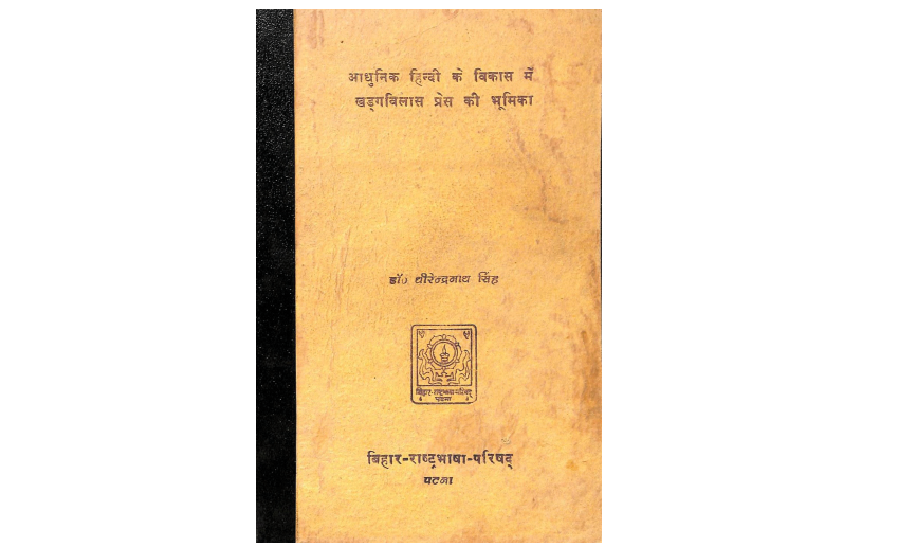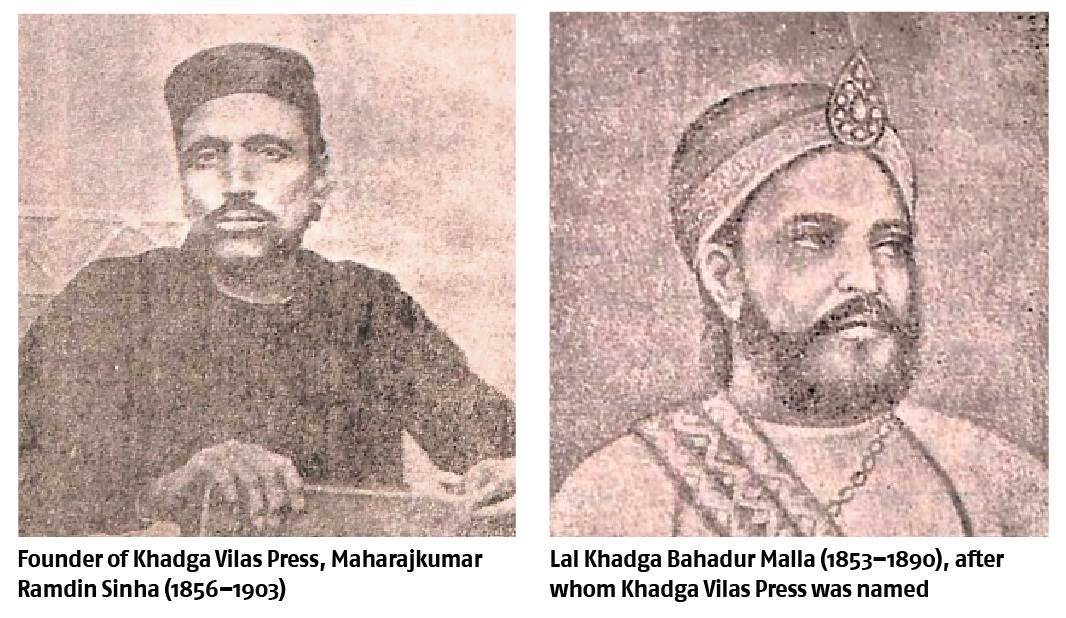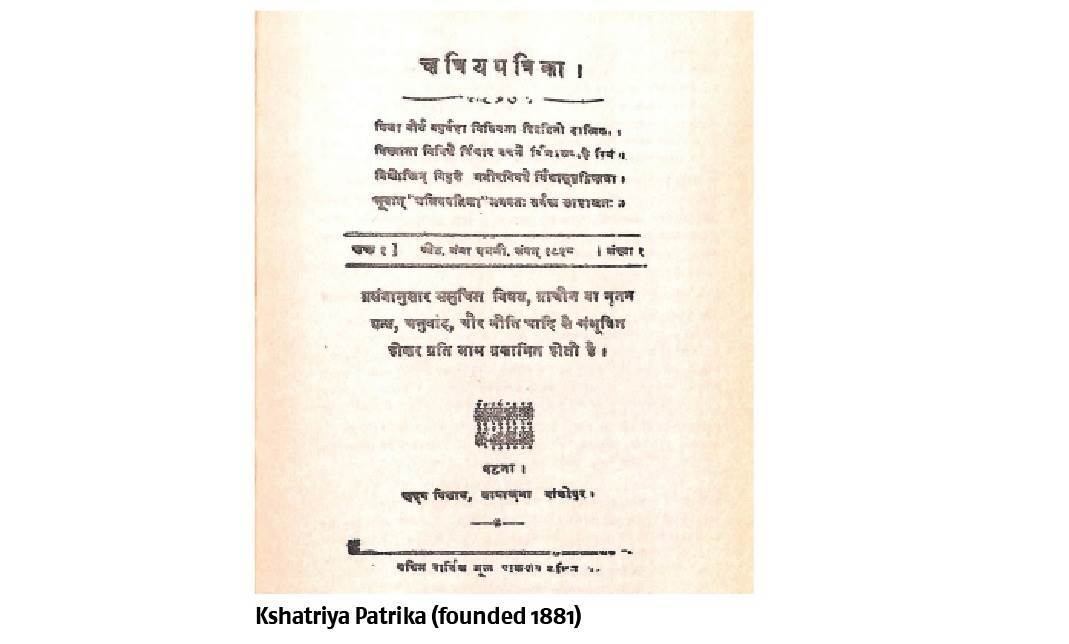Print History: Khadga Vilas Press, Patna - A Print Inheritance
A printing press becomes the bone of contention within the family and the legal records reveal a lot about the history of the press
31 Mar 2024 | By Murali Ranganathan
Rai Bahadur Ram Ranvijaya Sinha, the proprietor and manager of Khadga Vilas Press, died on 27 October 1936 at the age of 46. He was survived by three minor daughters, two younger half-brothers, and one of his four wives. His death sparked legal disputes that embroiled his descendants and Khadga Vilas Press for the next two decades. Who were the rightful heirs to Khadga Vilas Press? Besides the family, there were other parties involved in the legal proceedings. Three life insurance policies had been purchased from The Great Eastern Life Assurance Company in the name of Ram Ranvijaya Sinha. Who was entitled to its lucrative payout? The Bank of Bihar had extended a loan to Ram Ranvijaya Sinha and filed a suit to recover it. Who was to pay it back?

The bone of contention between the opposing parties was the business of Khadga Vilas Press and the extensive real estate and investment portfolio which had been acquired from its profits. Ranged on one side was his third wife, Parvati Kuer, her daughter and the two daughters of the fourth wife. Their opponents were the two half-brothers of Ram Ranvijaya Sinha, sons of his father’s second wife, Indrapati Devi: Sarangdhar and Ramji. Parvati Kuer claimed that the founder of Khadga Vilas Press was Saheb Prasad Sinha, the father of the first wife of Ram Ranvijaya Sinha. After his father-in-law’s death in 1901, the eleven-year-old boy inherited the press as part of his wife’s dower. His half-brothers could, therefore, lay no claim to its ownership. On the other hand, Sarangdhar and Ramji contended that the sole founder of Khadga Vilas Press was their father, Ramdin Sinha, and that Saheb Prasad Sinha was merely the printer and publisher of the Press. Only a thorough examination of the history of Khadga Vilas Press would reveal the truth.
Printing in Bihar
Though Bihar was considered a print wasteland for most of the nineteenth century, printing first reached Bihar as early as the 1820s. The Opium Agent of Patna, Sir Charles D’Oyly, ordered a lithographic press in 1823 which arrived a few years later. He not only sketched and painted but also did much of the lithographic work. The press, named the Behar Amateur Lithographic Press, seems to have been active between 1828 and 1831. Its output was illustrated books with titles such as Indian Sports (1829) and Costumes of India (1830). It produced five volumes of the Behar Amateur Lithographic Scrapbook (1828–30) which contained lithographs on a variety of subjects including portraits, flora, fauna and picturesque landscapes. Besides, D’Oyly, his wife and other Europeans, two Indian artists also contributed to these books.

A Christian missionary press was started by the Berlin Society in Muzzafarpur in 1846. Besides printing Christian tracts, it also published textbooks and magazines. There were a couple of printing presses in Patna in the 1850s but they were rather limited in their scale of operations. Only when the press which printed the Bihar Bandhu newspaper shifted from Calcutta in 1876 did a typographic press reach Patna.
The idea of a Hindi language began to grow stronger from the 1870s. Hindi was conceptualised as distinct from Urdu though they have the same grammar and syntax and a largely overlapping vocabulary. Written in the Perso-Arabic script, Urdu had displaced Persian as the language of the lower courts across Uttar Pradesh and Bihar in the 1840s. Hindi, written in the Nagari script, aspired to be the literary and business language of the region. By 1875, the Nagari script could be used in civil courts in Bihar. As the movement gathered pace, many organisations were founded in the final decades of the nineteenth century to further this idea. Perhaps the most prominent of these institutions was Nagari Pracharani Sabha of Kashi (Benares) founded in 1893.
But many years before the foundation of Nagari Pracharani Sabha, a group of young men in their early twenties from Bihar were engaged with the Hindi question. This group was led by Maharajkumar Ramdin Sinha (1856–1903), whose family claimed a lineage from one of the many zamindar dynasties of Bihar which had been influential in the eighteenth century. Though much reduced in circumstances, Ramdin’s family was still part of the upper echelons of Bihar society. After a few years of formal education, Ramdin began working as a schoolteacher. Others in the group included his classmate, Ramcharitra Sinha (1858–1882); a distant relative, Saheb Prasad Sinha (1855–1901), who worked as a compositor in the Bihar Bandhu Press; and a close friend, Lal Khadga Bahadur Malla (1853–1890) who belonged to a zamindar family. As they debated on how best to develop Hindi, it became obvious to them that a library of Hindi printed books needed to be created. And, perhaps, they could contribute to this library themselves. Khadga Vilas Press, thus, came into existence.
A new era in Hindi publishing
According to Dhirendranath Sinha, whose Adhunik Hindi ke vikas mein Khadga Vilas Press ki bhoomika [The role of Khadga Vilas Press in the development of modern Hindi] (Patna, 1986) is the only credible source of information on Khadga Vilas Press, its foundation inaugurated a new era in the history of Hindi language publishing and printing. Founded in 1880 in Patna, Khadga Vilas Press soon attained a pre-eminent status in the Hindi publishing world. Started at a time when Hindi was still being moulded into a literary language, Khadga Vilas Press played a seminal role in its development. For the first two decades of its existence, it was perhaps the only large printer and publisher of Hindi books east of
Lucknow where the Naval Kishore Press continued its prodigious publishing activities in Hindi and Urdu.
The press was perhaps named after Lal Khadga Bahadur Malla. Ramdin Sinha’s doting maternal grandfather gladly gave his favourite grandson the five thousand rupees needed to start the press. Since Saheb Prasad Sinha was the only person with some experience of having worked in a printing press, he was designated the manager of Khadga Vilas Press. His name appears as the printer and publisher of the books issued by the press. It started its existence with a single treadle press housed in a temporary structure located in the Chowhatta neighbourhood of old Bankipore in the ancient city of Patna. From this meagre start, Khadga Vilas Press grew rapidly and built its own premises to house its burgeoning print infrastructure, according to Dhirendranath Sinha:
Saheb Prasad Sinha was sent to Calcutta to buy flat platen presses. He purchased the famous Victoria Platen Pressses which were manufactured in London. In due course, the press purchased eight flat platen presses, eight treadle machines and a few proof presses. These presses were installed in the lower floor of the building. The manager’s room was located near the entrance. The upper floor had the composing section, a guest house and a library.
… The binding department was housed in a separate structure located outside the entrance to the printing department.
Ramdin Sinha encouraged a work culture where all the employees were part of one big religious family. Most of the senior staff including Ramdin Sinha stayed on or close to the premises. The employees, who numbered about a hundred, had to get up before 4 am. After a dip in the Ganges which flowed nearby, they gathered for communal prayers. They were fed breakfast (four kachoris and hot jalebis) before the press commenced the workday. The guest house on the first floor played an important role in the publishing activities of the press. It played host to many of the leading writers, poets and philosophers of Bihar when their books were being composed and laid out for printing.
Khadga Vilas Press shaped many aspects of printing and publishing in Hindi. Be it the standardisation of the size of literary publications, the choice and design of legible fonts for Hindi, or defining standards in Hindi orthography, the contribution of Khadga Vilas Press was significant. Its publications were carefully proofread and it strove to maintain the highest quality in all aspects of printing. It was perhaps the first Hindi publisher to pay royalty to its authors when the normal practice was to present the author a few copies of the book.
Ramdin Sinha was an excellent judge of books and their authors and also a proficient editor. He soon built up an extensive roster of writers who would later be recognised as the pioneers of modern Hindi literature. Chief among was Bharatendu Harishchandra (1850–1885), arguably the most important of the early Hindi littérateurs. He presented the publication rights of all his writings to Khadga Vilas Press which inspired an entire generation of Hindi writers to work with the Press. Khadga Vilas Press printed the complete works of Bharatendu in a uniform edition, again the first time a Hindi writer's entire oeuvre was published.

Not only did Ramdin Sinha edit and annotate the books he published, he was an author himself. His most important contribution was Bihar Darpan which contained biographies of important men associated with Bihar. He was also the editor of Kshatriya Patrika, one of the first periodicals to be published by Khadga Vilas Press. It built an impressive portfolio of monthly and weekly journals including Brahmin, Bhasha-Prakash, Shri Harishchandra Kala and Dvija Patrika. Though many of them had caste signifiers in their names, they were reformist papers that aimed to extirpate many of the social practises, such as child marriages, which were prevalent within these communities.
The increased use of Devanagari in every aspect of life in Bihar provided Khadga Vilas Press with numerous opportunities to expand its printing business. Be it forms for the revenue department or circulars issued by law courts, or for textbooks in numerous subjects with large print runs, Khadga Vilas Press was well placed to profit from these developments. Publication of religious texts was another mainstay for the press: the works of Tulsidas and Surdas went into many editions as did commentaries on these texts.
For a few years after Ramdin Sinha’s death in 1903, the press was managed professionally before his son, Ram Ranvijaya Sinha, took over the role. He expanded the operations further by starting a lithographic department and a type foundry. Khadga Vilas Press now had the resources to print in Hindi, Urdu, Kaithi, Bengali and English. Like his father, Ram Ranvijaya Sinha was also an active proponent of the Hindi language and the Nagari script. At the time of his death in 1936, Khadga Vilas Press had a publishing catalogue of nearly five hundred books.
Juridical denouement
Ram Ranvijaya Sinha’s widow, Parvati Kuer, was fighting very formidable opponents. The two brothers, Sarangdhar Sinha (1899–1982) and Ramji Sinha (1901–1960), were advocates with an extensive legal practice in the Patna courts. Sarangdhar Sinha was also a political activist. He was a member of the Indian National Congress from 1920 and took an active part in the Civil Disobedience Movement of the early 1930s. Elected president of the Bihar Provincial Congress Committee in 1932, he was arrested and imprisoned for eighteen months. When the Congress decided to take part in the 1937 provincial elections, he was one of the winning candidates from Bihar and was a part of the provincial cabinet. His acquaintance with the most powerful men in the province proved decisive in the legal proceedings.
The initial legal claims and counter-claims were made at sub-ordinate courts in Patna. The rulings, issued in the early forties, were partly in favour of the widow and her daughters. Both parties appealed the ruling at the Patna High Court in 1947, which eventually decided the appeals in 1953. The brothers could marshal a formidable group of witnesses on which the High Court relied: “Those respectable witnesses are Sri Ramdayalu Singh, Speaker of the Bihar Legislative Assembly; Sri Chandreshwar Prasad Narayan Singh, a big zamindar, a Member of the Legislative Assembly and Leader of the Opposition in the Legislative Assembly, and Sri Shyama Prasad Singh, another big zamindar and Deputy President of the Bihar Legislative Council.” Even Rajendra Prasad (later the President of India) and Srikrishna Sinha (later the Chief Minister of Bihar) had also deposed at the sub-ordinate court.

The account books (khata bahis) of Khadga Vilas Press, perhaps going back to its early years, were produced by both the parties to bolster their arguments. For some years, a Haveli Khata (residence account) was maintained by the family: a consolidated amount would be taken out of the business and transferred to Haveli Khata and the expenses of the entire family, including Ram Ranvijaya Sinha and his two half-brothers, would be met from this account. Later, the Haveli Khata was dispensed with and the family withdrew as much money from the business as it needed. These sums would be placed in the Amanat Khata (suspense account). A thorough examination of the transactions in these accounts supported the brothers’ contention that Khadga Vilas Press was a coparcenary, jointly owned by all members of the family. Parvati Kuer found herself on the losing side but at least she had a share of the coparcenary.
The case filed by the Bank of Bihar against the family to recover its outstanding loan (about Rs 16,000) wound its way right up to the Privy Council. It ruled in 1948 that the loan was taken by Ram Ranvijaya Sinha in his personal capacity and not for the business of Khadga Vilas Press. Thus the business and its owners could not be held liable for it. Parvati Kuer, again on the losing side, was held liable for the repayment of the loan. On the other hand, the courts held that the premiums for the insurance policies had been paid from monies generated from the business of Khadga Vilas Press. And the payouts went, not to Parvati Kuer, but to the joint family account.
The demise of Rai Bahadur Ram Ranvijaya Sinha altered the business of Khadga Vilas Press in many ways. Sarangdhar Sinha could hardly spare any time from his multifarious activities for the management of the press. From 1937, it gradually reduced its publishing activities and became a job printing press. One of its clients was the Patna High Court whose cause lists were printed at Khadga Vilas Press from 1936, with hardly any interruptions, for nearly fifty years.
Sarangdhar Sinha retained his seat in the Bihar Legislative Assembly until 1951. He was then elected for two consecutive terms as a member of the Indian Parliament from the South Patna constituency. He was also the vice-chancellor of Patna University from 1949 to 1952. When he retired from active politics, he was designated the vice-chancellor of Ranchi University in 1962, a post he held for three years. Khadga Vilas Press continued to function in these decades as a job printing press. It celebrated its centenary in 1980 but its operations dwindled after Sarangdhar Sinha’s death in 1982.












 See All
See All